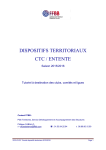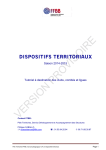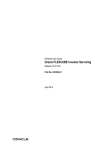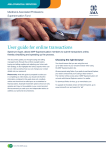Download User guide - Local Government Super
Transcript
User guide Getting started 1 zz What is the DIY investment option? 1 zz Is the LGS DIY investment option suitable for you? 2 zz Registering for the DIY investment option 3 zz Viewing your DIY account 4 zz Dashboard4 zz Stock quotes 5 zz News and research 5 Shares and Exchange-Traded Funds (ETFs) 6 zz Trading in the DIY investment option Term deposits 6 10 zz Setting up a term deposit 10 zz What to do at maturity 11 Managing your DIY account 12 zz Setting up a Dividend Reinvestment Plan (DRP) 12 zz Reporting on your investments 13 FAQs14 zz DIY Cash Account 14 zz Corporate actions 15 zz Dividend Reinvestment Plans (DRPs) 16 zz Tax17 zz Term deposits 18 zz Trading19 Issued by LGSS Pty Limited (ABN 68 078 003 497) (AFSL 383558), as Trustee for Local Government Super. In considering whether to acquire, to continue to hold the product or whether it is appropriate for you, please refer to the relevant Product Disclosure Statement at lgsuper.com.au Getting started What is the DIY investment option? The DIY investment option is a simple, low-cost alternative to a self-managed super fund (SMSF). It is a secure, web-based facility that allows you to invest a proportion of your super account directly in: zz a range of term deposits (one, three, six and 12 months) zz listed securities, such as: zz shares that comprise the S&P/ASX 300 Index zz a selection of exchange-traded funds (ETFs). The secure portal is available via your LGS Member Online account. In addition to investing in term deposits or listed securities, the portal allows you to: zz check the value of your investments zz access trading information zz view live information about the share market zz view and print a number of reports relating to your DIY investments. 1 Is the LGS DIY investment option suitable for you? The DIY investment option may be suitable for you if you wish to invest some of your LGS Accumulation Scheme or Account-Based Pension Plan account in a term deposit(s). It may also be suitable for you if you are looking to take a more active role in the investment of your super and you are comfortable that you have the skill and knowledge to invest directly in listed securities and construct and manage your own investment portfolio. Are you ready to take matters into your own hands? Before you register make sure you’ve read the DIY investment option Product Guide and feel comfortable taking control of your super investment. You’ll also need to meet the following eligibility criteria: l Be an existing LGS Accumulation Scheme or LGS Account-Based Pension Plan member with at least $10,000 in your account. As an investor in listed securities via the DIY investment option you would be taking on a role similar to that of a professional investment manager. It is therefore important that you: zz have a thorough knowledge of investing and investment markets zz understand the concept of diversification and its importance of having a diversified investment portfolio zz establish clear long-term investment objectives and have the discipline to follow them through zz understand that your investment risk profile may change over time, as you approach retirement and that your investment portfolio should change accordingly. If you are unsure whether or not you should invest in the LGS DIY investment option, it is recommended that you contact your LGS financial planner. l Have access to the internet and are registered for LGS Member Online. l Have a current email address that you’re happy to provide. l Have a Tax File Number (TFN) that you are happy to provide for tax purposes. l Have read and accepted the terms and conditions for the DIY investment option. 2 Registering for the DIY investment option 1. Log in to LGS Member Online Log in to your Member Online account using your LGS Member number and password. If you haven’t registered for Member Online, you can do so at lgsuper.com.au 2. Register for the DIY investment option Under the ‘Investments’ section of Member Online, you can register for the DIY investment option via the ‘Register Now’ button. Your registration will become effective the following day. 3.Transfer funds to your DIY Cash Account Once you have successfully registered, you may transfer up to 90 percent of your existing investment options to your DIY Cash Account. You must keep a minimum of $500 in your DIY Cash Account at all times to ensure you have enough money to cover the acquisition of any new investments and related fees and taxes. Any funds in your DIY Cash Account, in addition to this $500, can be used to invest in the DIY investment option. Please note it can take up to one week for transferred funds to be credited to your DIY account. 4.You’re ready to start trading As soon as you have transferred sufficient funds to your DIY Cash Account (in addition to the minimum level of $500) you are ready to start trading. 3 Viewing your DIY account To log in to your DIY account: 1. V isit lgsuper.com.au, log in to Member Online and select the Investments page. 2. On the left-hand side, click on the ‘Trade now’ button. This will open up a new window. If the window does not appear, make sure you have enabled pop-ups. Dashboard The Dashboard provides you with an overview of your DIY account. An example is to the right: 4 Stock quotes The Markets page provides access to information about the share market as well as individual shares. ‘View quote’ provides real time price information, including charts and market depth. Generate a stock quote Click on Markets in the top toolbar. 1. Generate stock quotes or access investment profiles by entering the company name or code in the search bar: ‘View profile’ provides a company investment profile of the share, including financial and profitability details. News and research As well as the stock quotes, the following information and tools are available to assist you when placing your trades or monitoring your investments: BRR Media provides access to an economic, financial and investment news service; this is where you can view audio and video webcasts featuring: zz information from ASX-listed companies about their business direction, performance and outlook zz the BRR Media Round Table—a weekly discussion with industry experts looking at the major stories of the Australian equity markets. Company investment profiles provide a snapshot of the share market including financial and profitability details for shares. These profiles are provided for all shares in the S&P/ASX 300 as well as ETFs. The information shown on the BRR Media website and in the company investment profiles is provided by third parties. The material is intended only as general information for your convenience, and should not in any way be construed as investment or tax advice, or projections of performance. 5 Shares and Exchange -Traded Funds (ETFs) Trading in the DIY investment option The DIY investment option provides you with access to the shares listed on the S&P/ASX 300 Index and a selection of ETFs. The shares listed on the S&P/ASX 300 cover a broad range of sectors, including finance, materials, industrial, energy, telecommunications, consumer staples, health care, utilities and information technology (IT). Note: sufficient available cash is required to trade in the DIY investment option. Buy new shares and ETFs 1. C lick on Shares in the top toolbar then click on the Buy shares button. 2. Type the company name or code into the search box. 3. Enter the trade value or quantity of shares or ETFs you would like to buy. 4. Enter your order details such as order type and expiration (Refer to Section 5. FAQs for descriptions of the order types). 5. Click Submit. 6 Buy or sell existing shares and ETFs Click on Shares in the top toolbar. 1. C lick on Buy next to the current holding or Sell depending on if you’re buying or selling. 2. In the pop-up box enter the trade value or quantity of shares or ETFs you would like to buy/sell. 3. Enter your order details such as order type and expiration. 4. Click Submit. 7 A brokerage fee will be added to the cost (for buys) or deducted from the proceeds (for sells) of each transaction. Refer to the DIY investment option Product Guide for details of the brokerage fee that will be charged. Managing open share and ETF orders Trustee investment limits are enforced at the time of purchasing shares. Refer to the DIY investment option Product Guide for details about these limits. 1. If you are able to amend an On-market order there will be a Modify button next to it, otherwise there will only be the option to Delete the order. Click on the button to modify or delete the order. Cash for share and ETF purchases will be reserved from your available cash when you place the order and withdrawn from your DIY Cash Account on the day of settlement. You can view and edit details of some of the orders you have placed by using the Recent orders section of the Shares page. Click on Shares in the top toolbar. Scroll down to the Recent orders section. 2. Adjust the Trade value and Quantity of the order. 3. Click Submit. 8 Corporate actions A corporate action is an event initiated by a public company that affects the securities issued by the company. Corporate actions may have a direct financial impact (eg. share purchase plan or share buyback); an indirect impact (eg. stock split, as the increased liquidity of shares may cause the price of the stock to rise); or no financial impact (eg. name changes). You can make a corporate action election from the Corporate Actions page. All corporate actions that you are currently able to participate in will be listed at the top of the page under the heading, Action required. 1. C lick on Corporate Actions in the top toolbar to view details of any corporate actions over your investments. 2. Click on the Info button to view the details of the corporate action. 3. The close date is the date by which your election must be made online for participation in the corporate action. 4. Click on the link to access the offer document which you are required to read before you participate in the corporate action. 5. Once you have read the offer document, click on the Elect button to make your election. 6. Enter your election in the election screen and click on Submit. 9 Term deposits offer the security of a fixed rate of return for the term you select. Term deposits They offer members the protection and certainty that some people want for their retirement savings. When you invest in a term deposit, you nominate the provider that you want to invest with (generally based on the interest rate), select the amount you wish to invest (a minimum of $5,000 is required per term deposit), and the length of time you wish to invest (eg. 3 months, 12 months). Your money is then ‘locked in’ to that term deposit until it matures. Setting up a term deposit Click on Term Deposits in the top toolbar to take you to the term deposits page. 1. U nder ‘Available term deposits’ select the provider that you wish to invest in and click Buy term deposit. 2. Select the maturity of the term deposit from the drop down menu. 3. Enter the value of your term deposit (minimum $5,000). 4. Click Submit. 10 If you have elected to roll over your term deposit: At maturity, proceeds will be paid to your DIY Cash Account and applicable earnings tax will be deducted. The rolled over amount will be deducted from your DIY Cash Account on the commencement date of the next term deposit. The roll over application will not proceed if you have insufficient available cash at this time. Rollovers of principal and interest may not proceed if the deduction of earnings tax reduces your available cash below the value of the principal and interest. Your new term deposit will be from the same provider and have the same term and maturity election. The applicable interest rate will be the prevailing rate at the time of processing the new application. What to do at maturity You can choose from the following maturity election options: zz Cash out: your principal and interest will be paid back to your DIY Cash Account at the end of the term (the default if no election is made). zz Rollover principal and interest: your principal and interest will rollover into a new term deposit of the same term with the same provider. zz Rollover principal only: your principal will roll over into a new term deposit of the same term with the same provider. Your interest earned will be paid to your DIY Cash Account. Term deposit maturity elections can be made or changed at any time once your term deposit application has been processed. An election must be made at least one (1) business day before maturity for it to take effect. Click on Term Deposits in the top toolbar to take you to the term deposits page. 1. Select Modify from the appropriate term deposit in the term deposits section. 2. From the drop down menu, select your new maturity election. 3. Click Submit. 11 Managing your DIY account Setting up a Dividend Reinvestment Plan (DRP) Dividend elections can be amended online at any time. An election must be made at least seven days before the security goes ex-dividend for it to take effect. You can elect for dividends to be reinvested (DRP) or to be paid into your DIY Cash Account. Click on Shares in the top toolbar to manage any dividends paid from your investments. 1. Y our current election is shown in the Dividend election column of the Shares table. To edit this election select Modify. 2. From the drop down menu, select your new dividend election. 3. Click Submit. DRPs Where no election has been made, your dividends will generally be paid to your DIY Cash Account. If tax is payable on receipt of the dividend, it will be collected from your DIY Cash Account. For some securities, cash payments or DRPs may be unavailable. In these cases, the security will show only one option, either DRP or Cash, and will not give you the option to modify. Reports Reports do not incorporate your superannuation money held outside this investment option. You cannot generate reports with a start date earlier than the date your DIY account was opened. 12 Reporting on your investments You can view a snapshot of your investments from the Dashboard, or take a more detailed view by viewing a report from the Reports page or selecting the Reports drop down menu from the Shares, Term Deposits and Cash pages. From the Reports page, you have the option of viewing reports on your cash transactions, income details, investment transactions, portfolio valuation, realised gains and unrealised gains. 1. C lick on Reports in the top toolbar to select the type of report you wish to generate. 2. To select the start date of your report click on the calendar next to ‘From’. 3. To select the end date of your report, click on the calendar next to ‘To’. 4. Click Update. 5. S elect the report format (print-ready PDF or Excel file) by clicking Export. 13 What is the difference between actual cash and available cash? FAQs DIY Cash Account How does my DIY Cash Account work? Your DIY Cash Account is an account through which all your transactions are processed. Purchases of shares and term deposits are funded from the available cash held in your DIY Cash Account. Proceeds from your investments, such as dividends and the principal and interest from your term deposits, are deposited into your DIY Cash Account. Any applicable taxes are also withdrawn from your DIY Cash Account. The interest you earn on the DIY Cash Account will be calculated daily and paid monthly in arrears at the end of each month. For more information on the DIY Cash Account, click on Important Information at the bottom of any page of your DIY account portal. Actual cash is the actual amount of cash you have in your DIY Cash Account. Available cash is the amount of cash available to purchase investments. Available cash does not include the minimum cash requirement or any cash put aside to fund a pending transaction (such as a share purchase). Available cash = actual cash – minimum cash – pending transaction amounts What are pending transactions? Pending transactions are transactions that you have placed and are awaiting settlement. They include: zz buy or sell trades of shares and ETFS which have either been executed ’on market’ or zz purchases of term deposits that have been lodged with the term deposit provider for processing. Pending transaction amounts will not appear in your DIY Cash Account as available cash. How do I view transactions into and out of my DIY Cash Account (eg. interest received or tax paid)? You can view your cash transactions by generating a Cash Transactions report or viewing the Recent transactions from the Cash page. Refer to ‘How to view and report on my investments’ for further details. 14 Corporate actions Do corporate actions always require an election to be made? If a security you hold is affected by a corporate action, you may be able to make an election and participate in the corporate action. For some corporate actions no election is required, you will not be notified, and you will automatically participate in the corporate action, eg. bonus issues or name change. For other corporate actions an election will be required in order to participate. You will only be able to participate in certain types of corporate actions, as approved by the LGS Trustee. How will I be notified about corporate actions? When a corporate action arises in which you’re eligible to take part, you will be sent an email. The email will include the closing date for that corporate action. This is why you need to ensure that your email address is current. How do I view the details of my outstanding corporate actions? The corporate actions that apply to your securities will be listed on the Corporate Actions page. Refer to ‘How to make a corporate action election’ for further details. Before making your election you need to read the offer documents relating to the corporate action which are available online via your DIY portal. What if I don’t make an election before the close date? If you do not make an election, the corporate action’s nominated default option (as defined under the terms of the corporate action) will apply to you. This may be to take no action and could result in a forfeiture or loss of securities, entitlements or consideration due. Can I change an election that I make online? Once you have submitted your election online you will not be able to amend your election. 15 Dividend Reinvestment Plans (DRPs) When can I make a dividend reinvestment plan (DRP) election? DRP elections can be made or changed at any time once you hold the security. The election must be made seven days before the security goes ex-dividend for it to take effect for that dividend. For some securities, either cash payments or dividend reinvestments may not be available. Refer to ‘How to set up a dividend reinvestment plan’ for further details. Which DRP election will apply for new shares that I purchase? In usual circumstances, the default election is for dividends to be paid into your DIY Cash Account. For some securities, either cash payments or dividend reinvestments may not be available. Investment restrictions Are there any minimum investment restrictions? The minimum buy trade value is $500 for shares and ETFs. The minimum order for a term deposit is $5,000. Are there any maximum investment restrictions? The LGS Trustee limits the maximum amount you can invest into shares and term deposits. Please refer to the DIY investment option Product Guide or contact Member Services for details of these limits. You can place orders to buy shares and term deposits from the Summary page. When you enter the purchase details the system will estimate the maximum purchase allowable based on the LGS Trustee’s limits. You will not be able to place an order that exceeds this maximum. In addition to these limits, the term deposit provider may impose maximum investment limits. Refer to the Term Deposit Terms and Conditions on the Term Deposit page. 16 Tax How will capital gains and losses be treated? If you realise a capital gain during the financial year, your account will be adjusted for tax on the sale that gave rise to the capital gain. Tax on capital gains and income earned will generally be deducted when those transactions are processed, however, any capital gain or loss as the result of a corporate action will be applied as part of year-end processing. As part of calculating your annual tax adjustment, capital losses on the sale of your assets will be applied against capital gains that you may have derived. To the extent that you have a net capital loss situation (ie. where the overall capital losses exceed the overall capital gains derived on your investments), as part of the year end member tax adjustment we may either: zz pay a capital loss benefit for all or part of your net capital loss. If a capital loss benefit is paid, the rate at which the benefit paid will be determined annually and vary between 10%-15% of the portion of the net capital loss subject to the benefit, or zz carry forward the net capital loss (to the extent that a capital benefit has not been paid to you on this loss) so that it is can be utilised in future year end member tax adjustments. The ability to pay you a capital loss benefit will depend on the overall capital gain position of the LGS DIY investment option and/or LGS as a whole. Will I receive the tax benefits of franking credits and tax adjustments? Any franking credits and relevant tax adjustments applicable to your account during a financial year will be applied as part of year-end processing; this is expected to occur by the following December. The total of any franking credits and relevant tax adjustments applicable to your account during the year will be credited to your DIY Cash Account in one amount. You must hold shares for at least 47 days before you are eligible for franking credits from dividends. To be eligible for a dividend, you must have purchased the shares before the ex-dividend date. Refer to the DIY investment option Product Guide for further details, including details in relation to eligibility for these benefits if you have closed your account during the year. 17 Term deposits I am about to purchase a term deposit – what interest rate will apply? You can apply for a new term deposit online at any time. Applications are submitted to the issuer of the term deposit on a daily basis. Term deposit applications close at midnight (Sydney time) and the term deposit will commence the following business day. Published rates are available on the Term Deposit page. Interest rates displayed are indicative and subject to change. In ordinary circumstances you will receive the rate published on the day of your application. Funds will be taken from your DIY Cash Account on the day the term deposit commences so you should ensure adequate cash is available in your DIY Cash Account. The interest earned on term deposits will be fixed for the term of the investment. Interest is calculated daily and paid on maturity. For more information on term deposits, refer to the Term Deposit Terms and Conditions on the Term Deposit page. When can I make a term deposit maturity election? Term deposit maturity elections can be made or changed at any time once your term deposit application has been processed. An election must be made at least one (1) business day before maturity for it to take effect. Which maturity election will apply for new term deposits that I purchase? Newly purchased term deposits will default to a maturity election of ‘cash out’ (ie. your principal and interest will be paid to your DIY Cash Account at the end of the term). What happens when my term deposit matures? You will receive a reminder notification by email approximately two (2) weeks before your term deposit matures. At maturity, if you have not elected to rollover your term deposit, your principal and interest will be paid into your DIY Cash Account and earnings tax will then be deducted (if applicable). If you have elected to rollover your term deposit by making a maturity election, your principal and interest will first be credited to your DIY Cash Account and earnings tax deducted (if applicable). The rollover amount (either principal or principal and interest, depending on your election) will then be deducted from your DIY Cash Account on the commencement date of your next term deposit. The rollover application will not proceed if there is insufficient available cash in your cash account at this time. Rollovers of principal and interest may not proceed if the deduction of earnings tax reduces your available cash below the value of the principal and interest. Your new term deposit will be of the same term and from the same provider as the original term deposit. It will also have the same maturity election as your original term deposit (you can amend this election online at any time). The rate that applies to your new term deposit will be the prevailing rate at the time of processing the new application. Can I break my term deposit? There is limited ability to break your term deposit before its maturity date and any such request must be made directly to the LGS Trustee in writing. An early withdrawal request may take up to 21 business days to be processed. Any request will be at LGS’ discretion and break fees will generally apply. Please refer to the DIY investment option Product Guide and the Term Deposit Terms and Conditions available on the Term Deposit page or contact LGS Member Services for details. 18 Trading What do I do if I am prevented from trading due to a technical issue, eg. website outage? In the event of the website being unavailable or if you experience a technical issue with the website that prevents you from trading online, please contact Member Services on 1300 LGSUPER (1300 547 873) between 8.30am and 5.00pm, Monday to Friday for more information. What is the difference between Market and Limit orders? All orders are subject to ASX rules and orderly market considerations. For more information on orders and trading, click on Important Information at the bottom of any page of the DIY portal to view the Trading Terms and Conditions. When will my order expire? When you place an order to buy or sell shares and ETFs you will be required to select if the order is to remain on market for ‘Today only’ or ‘Until cancelled’. Today only orders are valid for the business day on which they are placed and will expire before the market opens on the next business day. Until cancelled orders will expire after 22 business days of the order being placed if it has not been executed on market, cancelled at your request, or cancelled in accordance with ASX rules. When you place an order to buy or sell shares and ETFs you will be required to select an order type of Market or Limit. All orders are subject to ASX rules and orderly market considerations. For more information on orders and trading, click on Important Information link at the bottom of any page of the DIY portal to view the Trading Terms and Conditions. An order placed at Market (also known as Market-to-Limit orders) will seek to complete at the best prevailing buy or sell price at the time the order is placed. At Market orders may only be partially filled at the prevailing market price at the time the order is entered, depending on the volume of securities available or buyer demand in the market at that time. Why has my order been rejected? If you select at Limit you will be required to enter the limit price. An order placed at Limit will seek to complete only if the specified or ‘limit’ price is reached for your buy or sell order. Orders may not be accepted, may be incomplete, or may be purged from the market. For example, if you are attempting to place a trade on a security that is subject to a trading halt, you may be prevented from placing your trade and receive a message that the market is closed. To find out if a security is subject to a trading halt refer to the ASX website asx.com.au Please refer to the Trading Terms and Conditions (available in the Important Information link at the bottom of each of the DIY portal pages) for further information regarding the cancellation, failure or delay of certain transactions. Investment limits imposed by the Trustee of the Fund may also affect your ability to place orders. Please refer to the DIY investment option Product Guide for more information. 19 How will I know if my order has been successful? What is the meaning of each of the order statuses? You can view the status of your order on the Orders page. Orders that have successfully executed will have the status Execution Complete. Refer to ‘How to view and amend orders’ section of this guide for further details. Order processes and status description Term Deposit orders Authorised Awaiting Processing Validated Processed On Market Invalid You have authorised this order and it will be processed during the next business day. You have the ability to delete this order online. These statuses relate to the differing systems processes that the term deposit order will go through once applications have closed and immediately prior to execution of the order. This order is invalid and will not be processed. You have the ability to delete this order online. Shares and ETFs orders Authorised/ Awaiting Processing You have authorised this order and processing is currently underway. On Market This order has been placed on market and is awaiting execution. You have the ability to amend or delete this order online. Partial Execution This order has been partially filled. Execution Complete This order has been filled. Expired This order has expired and will not be executed. 20 How do I amend or delete an order? The ability to amend an order for shares, ETFs and term deposits will depend on the order status: zz For shares and ETFs you can amend or delete an order that has the status On market, Pending, Partial execution or Authorised. zz For term deposits, you can delete orders that have the status Pending or Awaiting processing. In most cases, your ability to amend or delete an order will only be available during market hours. You can amend or delete these orders from the Recent orders section of the Shares or Term deposits page by clicking on the ‘Modify’ and ‘Delete’ buttons. Refer to ‘How to view and amend orders’ section of this guide for further details. How do I view my recent orders? The Recent order pages display information about recently placed orders, including: zz the order number zz the date the order was placed zz the transaction type zz the amount and zz the status of the order. Details of executed orders older than 30 days can be viewed in the reports available from the Reports page. L0437-03/15-web 21
































